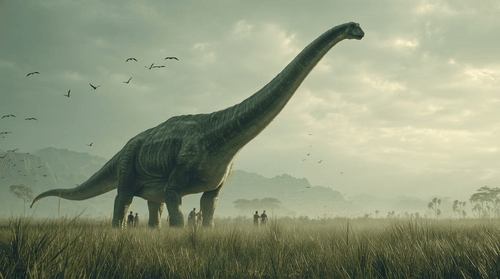The Bible is literally true, but not always literal. Let’s unpack the biggest question at the crossroads of science and faith.
🦕 Did Dinosaurs Live with Humans?
The short answer:
Maybe. Maybe not.
Possibly.
Honestly? I don’t know, and neither do you.
That’s the closest thing to a theologically sound answer you’ll get from anyone being truly honest.
But let’s unpack this question seriously, because it sits right at the crossroads of science, faith, and our shared fascination with enormous lizards that could eat us.

This debate is akin to a fossil itself. It seems to last forever.
Ask ten Christians what they think about dinosaurs, and you’ll get ten different answers:
- The Young Earth crowd: “Of course, they lived with humans! They were on the ark, right next to the kangaroos!”
- The Old Earth camp: “No, they went extinct millions of years before humans appeared.”
- The conspiracy theorists: “Dinosaurs were made up by the government to discourage us from inventing time travel.”
- The ‘I just love Jesus’ group: “Who cares?”
To be fair, there’s no verse in Scripture that says, “And Adam did feed the velociraptors, and lo, they were good boys.”
But there are plenty of passages describing enormous, mysterious creatures— beasts that make us wonder if the biblical writers saw something we’d now call prehistoric.

Enter Leviathan and Behemoth
If you’ve read the book of Job, you’ve met these two. In Job 40–41, God describes them in poetic detail:
Behemoth: a colossal land creature with bones like bronze and muscles like iron.
Leviathan: a terrifying sea monster, breathing fire and impossible to tame.
Some have argued these were literal dinosaurs, maybe a sauropod and a marine reptile.
Others insist they were mythic symbols of chaos and judgment.
And honestly? Both readings have merit, depending on what you do with biblical poetry.
Because Job isn’t a scientific textbook; it’s an ancient poem wrestling with suffering and the mysteries of creation.
When God points to Behemoth and Leviathan, He’s not giving Job a zoology lesson; He’s saying, “Look at the wildness and power of creation, Job. You can’t control it, but I can.”
Herein lies an important lesson for reading the Bible: The Bible is literally true, but not always literal.
Here’s what we mean…
When Jesus says, “I am a door.” He isn’t describing his actual, physical being. That’s silly. He’s describing Himself as the gatekeeper of salvation, and that those who want to enter heaven must go through Him… you know… like a door.
Many interpret Job similarly, saying that it isn’t speaking of literal dinosaurs…
But there’s a catch to that… we actually have entire museums filled with bones and fossils. How do we reconcile the real existence of these creatures with the accounts we have from the Bible acknowledging their existence?
LET’S SAY HUMANS AND DINOS LIVED WITH EACH OTHER
What would that have looked like?
We made a Biblical version of the Flintstones down here (not really, but close enough. Tap here, and you’ll see.)👇🏽

Even outside of Job, Scripture is filled with references to great beasts. The Bible is filled with serpents of the sea, dragons of the deep, and creatures that seem half-real, half-symbolic.
Psalm 74:13–14 speaks of God crushing the heads of sea monsters and the “Leviathan.”
Isaiah 27:1mentions God slaying “the dragon that is in the sea.”
Revelation describes a “great red dragon” (Rev. 12:3).
In many cases, these may be metaphors; ancient imagery representing evil, chaos, and the forces that oppose God.
But then again… how did these metaphors become so universal? Why did nearly every ancient civilization (from Mesopotamia to China to the Americas) describe massive reptilian beasts in their myths?
Were these all just poetic inventions? Or were they collective memories of something that once walked the earth, passed down and distorted over time?
We don’t know. But it’s an interesting question.
What’s the real point here?
Whether humans ever shared the planet with dinosaurs is, in the grand scheme of salvation history, a pretty small issue.
Genesis tells us who made the world and why. We aren’t given a detailed timeline of what lived on it at the time.
The Bible wasn’t written to satisfy our curiosity about the Jurassic period. It was written to reveal God’s character, humanity’s fall, and His plan to redeem creation through Jesus Christ.
And yet, there’s something beautiful about how Scripture preserves the awe and terror of the natural world… a world that still bears the echoes of its untamed past.
Leviathan, Behemoth, the great beasts of the deep… they remind us that creation is not small or safe. It’s vast, mysterious, and wild… just like its Creator.





